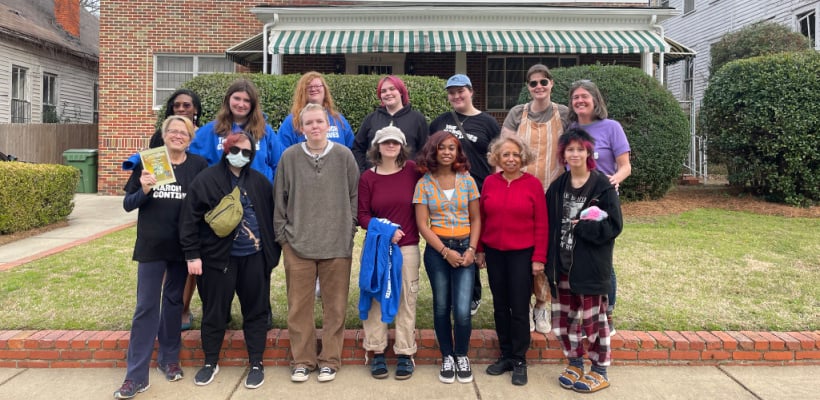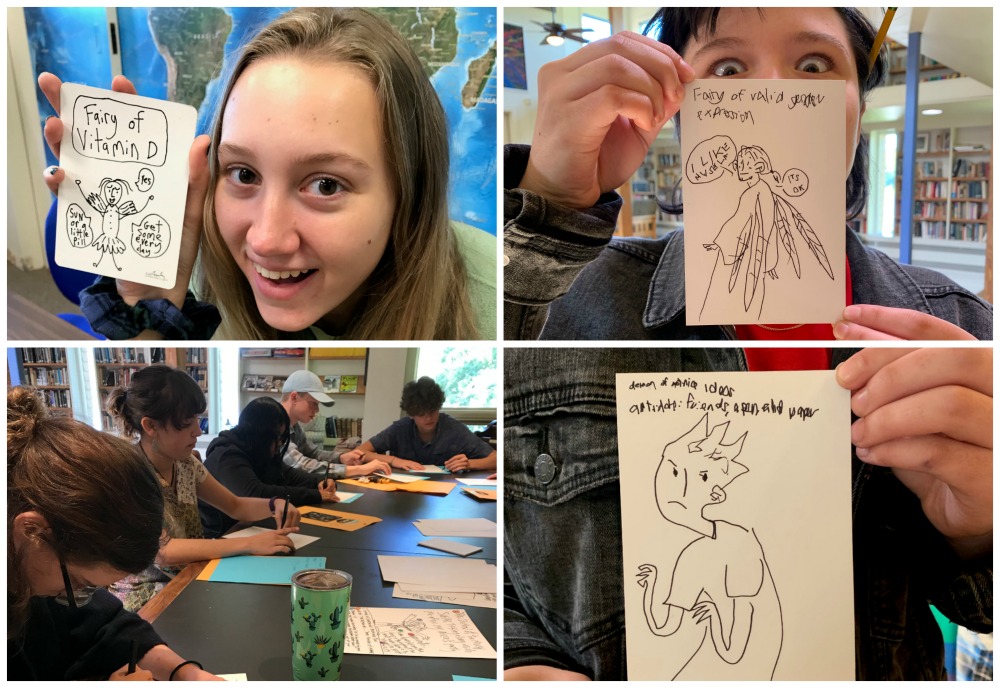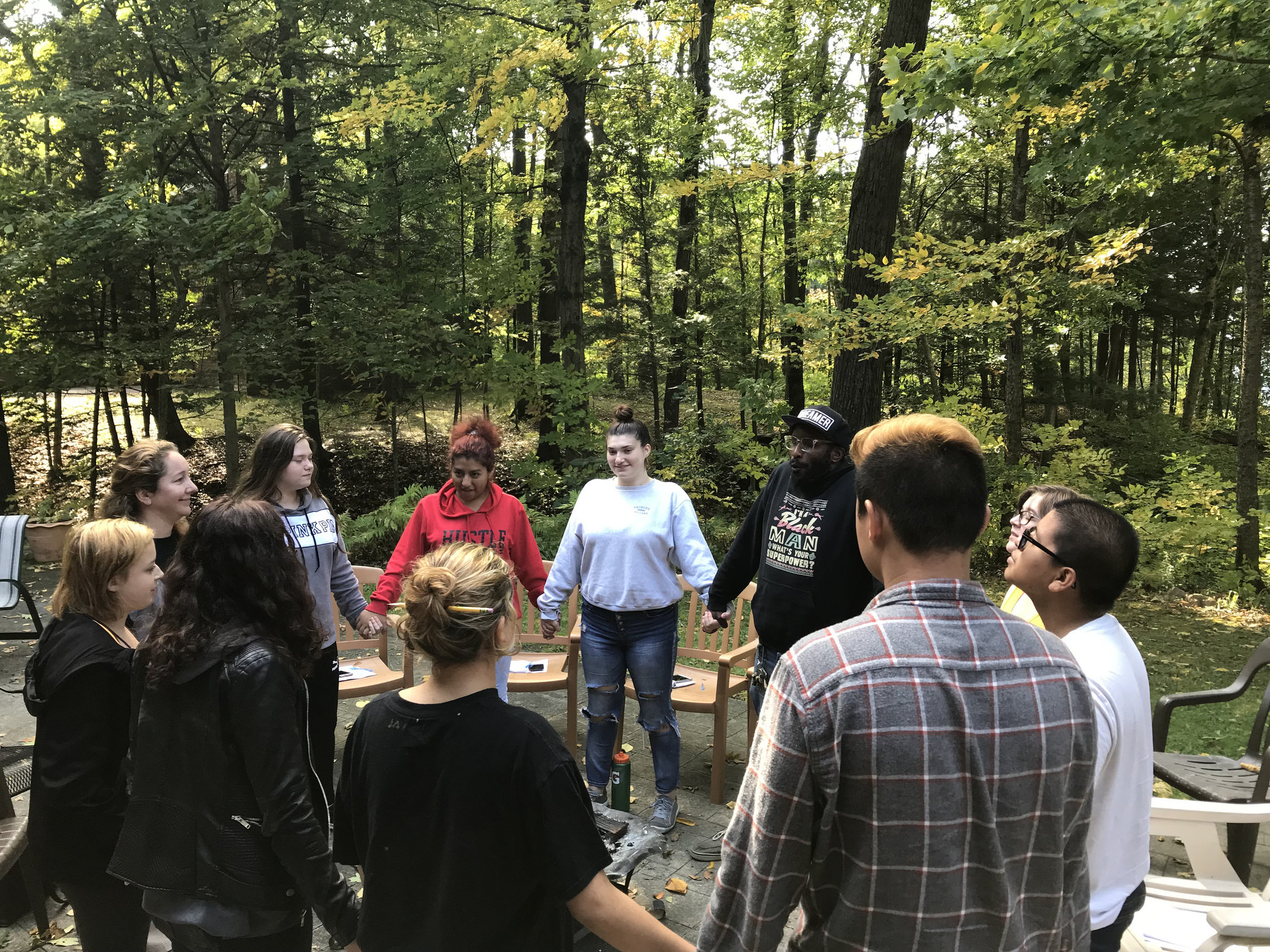Fairies and Demons: Creative Workshop
On Tuesday, September 17, local artist Emily Anderson brought her “Fairies & Demons Workshop” to Rock Point School. All of our students took part in...
 Rock Point group poses outside the Harris House with Velma Harris
Rock Point group poses outside the Harris House with Velma Harris
In February, an intrepid group of students and staff set out on our second annual Racial Healing trip to Georgia and Alabama. Through this trip, students and staff hoped to gain a deeper understanding of the history of racism and oppression in our country and how that history impacts us today.
This group of students was impressive in their commitment to this trip and their work while in Alabama. From having a positive attitude about the challenges of travel (hello, 4 a.m. flight) to being open to hearing many different stories and perspectives as they visited historical sites and museums, they showed a clear sense of purpose and a genuine desire to learn.
The group was off and running from the moment they stepped off the plane. The first place they visited was the Legacy Museum in Montgomery Alabama. The museum, built on the site of a cotton warehouse where enslaved Black people were forced to work, tells myriad stories of slavery in America through first-person narratives, art, interactive media, and data-rich exhibits. Students were deeply moved by the exhibits. One 12th-grade student said, “I felt angry seeing the signs from the Jim Crow era, comparing black people to animals. I have read about segregation, but seeing those signs in person made me furious.” Another student was interested in how the Legacy Museum highlighted women's work in the Civil Rights Movement: "The women were the backbone of the movement, but the men were at the forefront getting the attention. It was illuminating to learn about so many women having crucial roles in fighting for Civil Rights.”
After visiting the Legacy Museum, the group traveled to Selma where they stayed for the majority of the trip. They felt lucky to stay at the Woolworth Lofts, above the 5 & Dime, which has been turned into a Community Arts Center. At the 5 & Dime, Joyce O’Neal, a footsoldier of the Civil Rights movement, greeted the group. Joyce’s mother was a school teacher who inspired her children to stand up for what was right. Although the school district forbade her mother from speaking about protests, her mother encouraged the young people in her classes to get involved in any way possible. Joyce was trained in nonviolent protesting and participated in many marches and protests. On Bloody Sunday, she was tired from marching and happened not to go to the Bridge that day. She ended up helping wounded protesters in the local Church as they fled from the Edmund Pettis Bridge. One 11th grade student said of Joyce, “It was amazing to hear her stories firsthand and to really humanize the movement. She’s amazing.”
 Another trip highlight was visiting St. Paul’s Episcopal Church with Father Henry Hudson. Fr. Henry shared stories of growing up in Selma during the Civil Rights movement. As a white person, he did not realize the significance of what was happening because his family ignored the Civil Rights movement and wouldn’t speak about it. He believes that his work now is to atone for that past and one way he is doing that is through his work in the Childers Chapel Cemetary. Henry Hudson’s family was buried there, and he had heard stories that there were graves of enslaved people outside of the fences. While walking the perimeters, he noticed depressions where enslaved people had been buried and found a few grave markers. Since this discovery, he has applied for a grant to clean the cemetery and make it a memorial for the enslaved people. While our group was there, they worked with Fr. Henry to clean gravestones and remove brush so that this memorial project could move forward.
Another trip highlight was visiting St. Paul’s Episcopal Church with Father Henry Hudson. Fr. Henry shared stories of growing up in Selma during the Civil Rights movement. As a white person, he did not realize the significance of what was happening because his family ignored the Civil Rights movement and wouldn’t speak about it. He believes that his work now is to atone for that past and one way he is doing that is through his work in the Childers Chapel Cemetary. Henry Hudson’s family was buried there, and he had heard stories that there were graves of enslaved people outside of the fences. While walking the perimeters, he noticed depressions where enslaved people had been buried and found a few grave markers. Since this discovery, he has applied for a grant to clean the cemetery and make it a memorial for the enslaved people. While our group was there, they worked with Fr. Henry to clean gravestones and remove brush so that this memorial project could move forward.
Our group made another impactful connection by visiting the Harris House in Montgomery, Alabama. Richard Harris was the only black pharmacist in Montgomery, and his house became a safe house for freedom riders and Civil Rights Activists. Velma Harris, his daughter, gave our students a tour and spoke about her experiences as a teenager who was growing up in this environment. She remembered being so impressed with all the “handsome guys” who were coming through her house, sharing spaghetti dinners, and listening to records. Some of these handsome guys were youthful John Lewis, Martin Luther King, Jr., and other young college student activists. Students could sit in the same place that these leaders sat, writing, talking, and laughing. Ms. Harris emphasized that although it was a tense and scary time, there was a lot of community joy in her home.
Finally, our group visited the Peace and Justice Memorial, a memorial to people who were lynched. There are over 4,400 names of people, but there are many more lynchings that are undocumented. As part of the memorial, there is a series of statues by Kwame Akoto-Bamfo representing the captured Africans who were sold into slavery. Moss, an 11th grader, remarked, “One memory that stands out to me was a marker for a county in Indiana that had 20 people, all unknown and unnamed, who were lynched on the same date. When I looked up the incident, nothing came up. There was no record of what happened anywhere.” This memorial highlights a time, the people, and the horrific events that have been glossed over in our historical records.
Our group of students and staff were extremely moved by their experiences on this trip. The personal connections they made as well as the historical connections will continue to have ripple effects in their lives and work. We look forward to returning to Selma again next year and seeing our connections blossom.
Click here to see a slide deck our students and staff created with more information and photos from the trip.

On Tuesday, September 17, local artist Emily Anderson brought her “Fairies & Demons Workshop” to Rock Point School. All of our students took part in...

(photo taken at the Yelardy-Morganstern home before they took off for the airport)

For the second year, students participated in a day of poetry called "Share Your Heart, Share the World" with the Sundog Poetry Center. This year,...